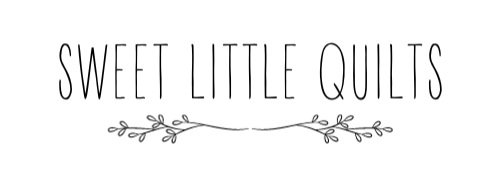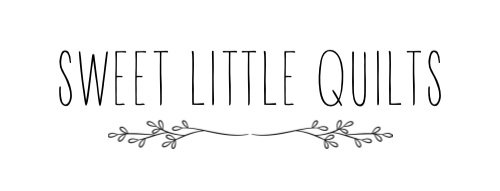A Modified English Paper Piecing Tutorial
English Paper Piecing has been around far longer than me and the beautiful designs created from small pieces of fabric, paper pieces, needle and thread are amazing. But, there are times when I’m stitching a piece that I start imagining doing it a different way. It’s not that I think everyone has had it all wrong, but I like to try new methods. Sometimes they work, sometimes, not so much.
Today, I am sharing the method I used to make the flower garden blocks for the Heirloom Flowers Quilt Pattern. It is not something I would use for every project, but worked perfectly for this pattern. With only five flower garden blocks that would be appliqued to a background fabric, I loved that they could be made with a finished edge, no paper to deal with and could be stitched in the traditional whipstich way … and believe it or not … can also be machine stitched! GASP! I’ll save that tutorial for another day. With so many quilters unable to do hand sewing due to arthritis or hand injuries, it is a great method to try.
If you want to make EPP blocks without papers and do not mind being at an iron for a bit, this method could do just the trick. This does not necessarily make things faster at the start, but helps in the end. So, here’s my sweet little tutorial on a modified EPP method. Please read all of the directions before beginning. There are links included for more information.
To get started you will need:
template from cardstock or lightweight cardboard (from packaging, paper plate, etc.)
scissors and/or rotary cutter, ruler and mat
starch or fabric stabilizer
aluminum foil - You do not need it to be heavy duty.
fabric
iron and ironing board or pressing mat
water soluble glue
needle and thread to hand sew the EPP shapes and applique
sewing machine if doing the applique by machine
You will need to start with a template.
I make my templates with my AccuQuilt machine, but they can be cut from cardstock or thin cardboard from a cereal or cracker box. I cut mine from packaging.
Cut out your fabrics.
These can be scissor or rotary cut 1/4” to 3/8” beyond the template edges. I found that going to the larger size 3/8” helped as some fabrics shrink slightly when starched. These can be fussy cut or cut in a stack, whichever works best for your planned design.
Starch your fabrics.
You can starch your fabrics before cutting, but I did mine after cutting. I use Purex Sta-Flo Concentrated Liquid Starch, mixed 1:1 with water. A fabric spray stabilizer is also a good choice or a stronger mix of starch to give more body to the fabric. You can experiment to see which you prefer. I chose to spray the entire hexagon to give the fabric more body, but you can focus more on the outer edges.
Begin layering with the foil.
To prepare your hexagon, you will layer in this order:
aluminum foil on bottom
fabric hexagon, right side down
cardboard/cardstock template
Press the foil and fabric onto the first side of the template, taking care not to bend the template and making a straight edge. Continue to the next sides with the fabric and foil secured around the template. Work your way around the template either clockwise or counter-clockwise, whichever works best for you.
Once I get started, I make 3-4 templates and spray several hexagon fabric pieces at a time. This allows me to prepare the hexagons in an assembly line.
Press the foil-enclosed hexagon.
Press the hexagon with the foil side down for a few seconds before turning it over and pressing for a few more seconds. You want to leave the iron on the foil long enough to heat-set the starch, but do not need to fully dry the fabric.
Please note that aluminum foil conducts heat, so it will be HOT! You can use a turner (pencil, pen, pin, etc.), but be careful not to burn your fingers. Once you’ve pressed both sides, let it set to cool. This is when I make the next hexagon stack, heat set … make another, heat set … before opening the first one.
Remove the fabric.
Once the foil has cooled, remove the prepared hexagon by carefully opening the packet. You will be reusing the template and foil.
Press the prepared hexagon on both side. The fabric should not be wet after this.
Continue preparing your hexagons.
For the Heirloom Flowers blocks, you will prepare three rows of hexagons from the center (Row 1) out. The example has the gold floral fabric for Rows 1 and 3, gingham row 2.
Row 1 - 1 hexagon prepared in the example above, with the fabric and foil enclosed around the template on all six sides.
Row 2 - 6 hexagons prepared with the fabric and foil enclosed around the template on five sides.
Row 3 - 6 hexagons prepared with the fabric and foil enclosed around the template on five sides AND 6 hexagons prepared with the fabric and foil enclosed around the template on four sides.
Row 1 is the only hexagon with the seam turned in on all six sides. For Rows 2 and 3, one or two sides are left with the raw edge/seam left open. This will allow you to applique the previous row on top of this seam instead of joining them in the traditional EPP method.
It’s time to sew the block together.
Lay out the prepared hexagons. For Rows 2 and 3, the raw edges will go to the center. With two differently prepared hexagons for Row 3, you will alternate the two pieces (with 2 open sides and with 1 open side) to nest around Row 2.
Beginning with Row 2, sew the prepared hexagons together following usual EPP stitching. The only difference is that you are only sewing Row 2 pieces together to make a row without the center.
Then sew Row 3 together, taking care to match the pieces correctly with the open/raw edge seams in the middle of the row.
Applique the center onto Row 2.
*See photo below for example.
With the wrong side up of the Row 1 hexagon, add a few dots of glue on the folded over seam line. Do this sparingly. You only need a little to hold this in place. With Row 2 facing up, place the Row 1 hexagon on top, matching it to the seam lines on Row 2. Press in place with your hand. You can leave the glue to set in 5-10 minutes or heat set with an iron.
CAUTION! If you are using light fabrics, your glue dots can scorch with an iron. If in doubt, do not use the iron.
Once the glue is set, applique the Row 1 hexagon onto Row 2 using a an invisible stitch by hand or if using a machine, you can use a straight stitch, zig zag or blanket stitch. For the stitches to be less visible, match your thread to the piece being appliqued.
An invisible hand sewn stitch was used in the example.
Applique Row 2 onto Row 3.
Prepare Row 2 to applique onto Row 3 by center and placing it on top, matching the seams. Fold down the top to avoid moving the row and add dots of glue along the outside edges. Be careful not to get the dots too heavy or close to the edges. Once the glue dries, it is hard to stitch through the glue. Hold and heat set in place. Once set, raise the lower half, add glue dots, return to the position and heat set in place.
Once the glue is set, applique in place following the directions from appliqueing the center to Row 2.
You now have an Heirloom Flower!
Once your block is finished, it is ready to applique to the background fabric. You have prepared edges to applique (unlike sewing hexagons with a running stitch) and there are not papers to remove (as in regular EPP).
NOTE: I did not use fabrics that required to be turned in a specific way. If you have fabrics that are directional or want them to land at a specific place, you will need to take this into consideration before turning them in the foil packets and pressing.
There is also an introduction to this method on my Instagram account @sweetlittlequilts. This is only one method and what I chose for my Heirloom Flowers Sample Quilt. It made the process easy and perfectly prepared to sew the rows before doing the applique. I find it fiddly to work with paper when doing EPP and bending and folding to add the pieces as rows are added.
I use a similar method for more complex EPP blocks. For these, I prepare my pieces using iron-on EPP shapes that are water soluble and my pefered “paper” for EPP. I still prepare the design by rows, leaving seams open at the center of each row and appliqueing the previous row on top. For me, it combines my love of hand sewing and adding applique to sew full rows together at once instead of piece by piece. You can see an example of this on my Expanding Dresden block and Crowning Star blocks (patterns by Elise Baek).
I hope you enjoy this tutorial. I would love to hear your thoughts or answer any questions. And …
Happy Sewing!
Debbie












